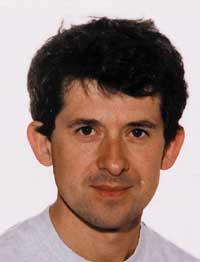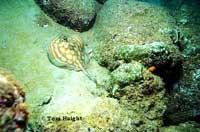Fossils of dinosaurs, crocodiles and Basque turtles in memoriam
1996/05/01 Murelaga, Xabier | Nuñez-Betelu, Koldo | Pereda-Suberbiola, Xabier Iturria: Elhuyar aldizkaria
We all have in memory the streets, squares and roads of our childhood and we have all seen modifying them. It is evident the change that has suffered the landscape of our cities, continuously and at a dizzying pace. Even the natural environment is in constant change, but in itself and maintaining harmony and balance. Unfortunately, the almost virgin, harmonious and balanced places we have all known are increasingly scarce, since humans are “urbanizing” nature itself.
To explain the evolution of certain beings, the theory of the Taidun Equilibria is used, that is, the unchanged times were interspersed with slight variations. In our view, the same theory was applicable to the evolution of the landscape, that is, to the geological and biological environment. In this way, changes in times of ecstasy or tranquility occur gradually: phyletic speciation in living beings, erosion and slow tectonic activity in rocks, for example. But the times of ecstasy are interspersed with moments of profound and very light changes. That is, in the history of the biosphere and the geosphere it is said that tranquility is normal, but occasionally there are violent breaks of the natural balance that are often harmful. And today, human beings are deeply destroying the natural balance.
If we analyze the geological and paleontological history, we will see that with the environmental changes also in the Basque Country have appeared beings and have been destroyed. For example, about 100 million years ago the sea, like a gulf, covered the Basque Country. At that time the climate was very mild, very tropical, and in the local sea the reefs of the Bahamas resembled the current ones, which today are areas of Gorbeia, Aizkorri, Anboto, etc. What's more, as the footprints of Armintza show, in the deltas of the rivers that came from the North were the dinosaurs.
Later, to the south of the marine gulf of the Campanian Age of 80 million years ago, prevailed the giant lizards, the sea turtles, the sharks and the tramanes, as indicated by the rocks of the Port of Vitoria. Five million years later, before this era ended, in Treviño County, in the beautiful delta of the river that came from the south, there were all kinds of terrestrial reptiles. Both in the tropical vegetation and in the mud of the marshes, there lived dinosaurs, crocodiles, turtles, snakes and the first Basque mammals of different sizes and sizes, and in the sky, the pterosaurs were the kings of the flying reptiles worthy.
In addition, some of these species are Basque animals par excellence, since they have been found for the first time in them. However, this delta did not last forever and the sea again covered these territories. In these areas sharks, fearsome mosasaurios and plesiosaurs similar to those of Loch Ness replaced the dinosaurs and mammals of the terrestrial zone. But Euskal Herria was no exception and, as happened all over the world, along with the shock of an asteroid, dinosaurs and most marine reptiles were destroyed at the end of the Cretaceous, 65 million years ago.
Since then the sea has receded in Euskal Herria and gradually, with the rise of the Pyrenees, the Basque land has emerged. Accompanied by mild climates, crocodiles and turtles continued their quiet life in the rivers of present-day Araba and southern Navarre and in the lakes and marshes of the Ebro. However, due to the environmental changes, during the Miocene the Basque crocodiles, the last European crocodiles, became extinct forever in the sight of the flamingos. Later, 17 million years ago, the Mastodoros predominated in the savannahs of southern Navarre, equating to the landscape of present-day central Africa. But after this warm season came the glaciations and mammoths, the ice covered our mountains and modelled the current landscape.
As we have seen, the Basque biosphere and the geological medium have undergone continuous changes without human influence. When these changes have occurred quickly and violently, they have been considered harmful beings. Thus many Basque species have disappeared and destroyed. Today, Nature suffers even more drastic changes in human influence in Euskal Herria. As history has taught us, environmental changes have brought terrible consequences for beings and, however, forgetting the consequences of immigrants, we are blindly and violently transforming our physical and biological landscape, profoundly curbing the ecstasy of the centuries. We will change this trend as soon as possible before nobody wrote Euskal Herria and the World in memoriam.

Gai honi buruzko eduki gehiago
Elhuyarrek garatutako teknologia





